|
|
|
Dinosaur Fossils
Scientists know a lot about dinosaurs and other prehistoric creatures
because they have found fossils.
On this page, you can find more information about fossils:
Fossils are preserved remains or traces of animals, plants and other
organisms. They are generally found in rocks.
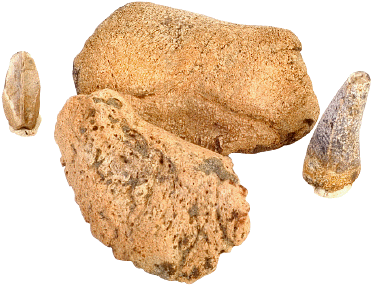
Most fossils are found in sedimentary rocks that form from the deposits
of sand and mud.
When an animal or plant dies, its body can get buried into
sand or mud. Then, over ages (millions of years), the sand or mud gets
compacted, and eventually turns to rock. Minerals can also leach into
the animal's body, helping to preserve it.
Similarly, just as animals' bodies and plants can be preserved by this
process of fossilization, so too can animals' nests, burrows,
footprints,
dung, etc.
Of course, most animals and plants
that die are not preserved in this way. Likewise most nests, burrows, footprints,
dung, etc., are also not preserved.
It is far more likely that they are destroyed - for example, bodies
can be eaten by scavengers or rot away, footprints can be washed away, and
so forth. It is only rarely, when all the circumstances happen to be just right,
that a fossil is formed.
There are two kinds of fossils:
- Fossilized Body Parts
These are fossils formed from parts of an animal
such as:
- Teeth

- Bones
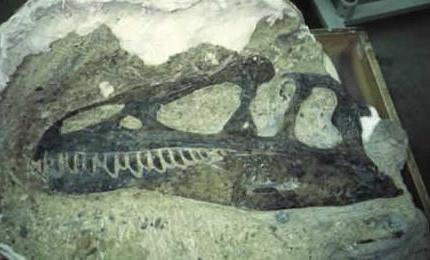
- Claws
- Skin, scales, feathers, etc.
- Soft tissues
Since skin and soft tissues usually decay before being fossilized,
the most common parts of animals to be preserved in this way are the
toughest parts of the animal, especially teeth, and to a lesser extent bones.
- Trace Fossils
Trace fossils (which technically known as "ichnofossils")
are fossils
which show the living activities
of animals.
Such fossils can include (for example):
- Footprints
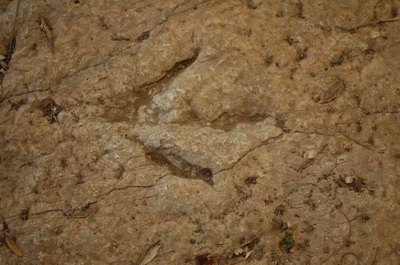
- Nests
- Burrows,
- Toothmarks,
- Dung (known as "coprolites"),
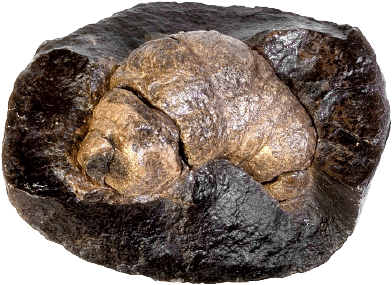
- Gizzard stones (the stones which some animals
swallowed to help digest their food)
From time to time, fossils in the ground are revealed by erosion - the wind
or rain erodes rock, revealing fossils contained within. It is therefore
likely than mankind has encountered fossils, including dinosaur fossils
since ancient, perhaps even prehistoric times.
- Some people think that dinosaur fossils found in this way, may perhaps
have inspired legends of dragons.
- One scholar (Adrienne Mayor of Stanford) has suggested that the legend
of the griffin (a mythical beast which supposedly had the head and wings
of an eagle, but the limbs and body of a lion), could have been inspired by
fossils of Protoceratops.
Greek drinking horn (rhyton) in the shape of a griffin, c.350 BCE:

The first modern scientific description of a dinosaur fossil was written
by
William Buckland.
Buckland wrote a paper in 1824 that was entitled: "Notice on the Megalosaurus or Great
Fossil Lizard of Stonesfield".
Since then, many other
scientists
have contributed to finding, researching,
dinosaur fossils.
Many scientists
(and quite a few amateur fossil-hunters too) have found fossils of
dinosaurs and
other prehistoric animals.
Fossils being cleaned and prepared at the Royal Tyrell Museum:
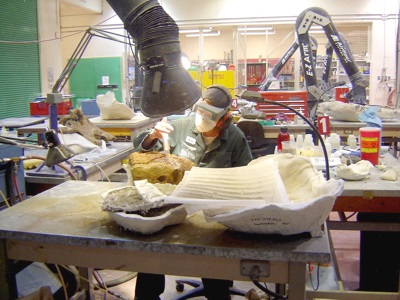 Some of the most famous fossil hunters include:
Some of the most famous fossil hunters include:
- William Buckland
(1784-1856)
who wrote the first scientific description of a dinosaur.
- Mary Anning
(1799-1847)
was a
fossil hunter who lived in Lyme Regis,
England.
Anning was responsible for the discovery of the fossilized s
skeleton of an
Ichthyosaur (the skeleton is now in
London's
Natural History Museum)
in 1811,
as well as
a Plesiosaur in 1821,
and a Pterodactyl in 1828.
- Edward D. Cope
(1840-1897) was an American paleontologist who
discovered over a thousand species of extinct vertebrates.
His exploration and research took place principally in
Texas
and
Wyoming.
- Lawrence Lambe
(1849 to 1934)
was one of Canada's
greatest paleontologists. He discovered and named many
types of dinosaurs,
and also studied other prehistoric animals.
- Othniel C. Marsh
(1831-1899) was a professor of paleontology at Yale.
He discovered the first
American
Pterodactyl fossils, and was first to scientifically
describe many different dinosaurs,
including
Apatosaurus
and
Allosaurus.
- Henry Fairfield Osborn
(1857-1935)
was an American paleontologist who was the
president of the
American Museum of Natural History, and also a professor
at Columbia University,
Osborn described and named
Tyrannosaurus Rex
in
1905,
the first fossils of the animal have been discovered by
Barnum Brown in
1902.
Osborn also did important theoretical work, and proposed
the theory of Adaptive
Radiation, in which animals and plants evolve into several species
by spreading and adapting to new areas and ecological niches.
- Barnum Brown (1879-1968)
was perhaps the greatest dinosaur hunter of the
20th century -
many people remarked on his uncanny ability to sniff out
dinosaur fossils. Brown began by
working as an assistant to
Henry Fairfield Osborn
in 1897, and during this career
discovered numerous species of dinosaurs and other animals.
His most famous discovery was the first
Tyrannosaurus Rex
ever found, in
1902
in Montana.
Related Information & Resources
See Also
Linking to This Page
We do hope that you find this site useful.
We welcome people linking to this website or citing us.
|
|
|



